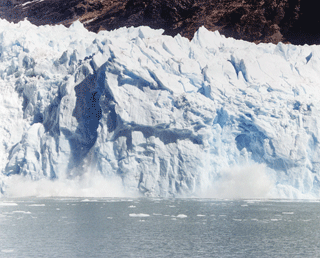Hyper-glacial describes the new reality
By definition, the word glacial means extremely slow, as in things moved at a glacial pace. With more than 200,000 glaciers in the world, it is important to get a sense of what is taking place in the current era of great change. Typically glaciers moved on the order of a few feet ( one meter) a day.
More than ninety percent of glaciers globally are now melting and getting smaller, in some cases at rates that are clearly visible. Glaciers and the ice sheets in which they are embedded, are the primary factor for future sea level rise in the decades ahead. They add to ocean height both as the meltwater finds its way to the sea and as icebergs calve off — as shown above.
As temperatures warm, the effect on glaciers is often dramatic, calving more icebergs, developing ponding water on top, which leads to structural collapse, internal fissures akin to fault lines and earthquakes, and water finding its way to the underside, where it lubricates the flow rate, with the glacier now moving on water, rather than grinding its way slowly directly on the bedrock.
In recent years some of the largest glaciers in the world are moving at double, triple, and even quadruple the rates from previous decades –– fifty or even a hundred feet a day. As glaciers experience really rapid melting and collapse, short-duration “surge” rates can move a glacier up to three hundred feet (one hundred meters) in a day. While that may not seem fast, it’s not only significant but will have far reaching, profound global effects.
Global glaciers and ice sheets contain enough frozen water to potentially raise global sea level an estimated 212 feet (65 meters) when they all melt. While that cannot possibly happen this century or next, even just melting five percent means ten feet (3 meters) higher sea level which would radically change every coastal community in the world, quite permanently. Even a single foot of higher sea level will be devastating as that raises the water level compounding the effects from sudden events like storm surge, extreme high tides, and record rainfall – a phenomenon that is happening more often along with the warming oceans.
When things double repeatedly it becomes exponential growth. Our brains have trouble recognizing exponential growth, even with simple situations like compounding interest. The effect is elusive until one does the numbers. You may recall the example of starting with a penny and doubling it every day for a month. Within 30 days it becomes ten million dollars. Or starting with a single drop of water in a large sports stadium, if it doubles in volume every minute, in just 47 minutes the stadium would be filled to the top.
Of course, there are practical limits to how long glacier speeds can double. But even with just 5 “doublings” from the current rate of a sixth of an inch a year, sea level would be rising more than five inches a year. (For example, starting with half an inch, doubling or exponential growth would yield 1, then, 2, then 4, then 8, 16 inches a year. While that might seem like some science fiction scenario, 14,000 years ago sea level rose more than a foot a decade.
We are now warming hundreds of times faster than the natural warming cycle, coming out of the “ice age” periods. We could very well have a foot or two of higher sea level by mid-century. We need to start using language and concepts that help us describe and understand the very different era in which we now live.
I have been searching for a term to convey that we are in a new era with glaciers melting and sea level rising at rates unknown in human history. Hyper-glacial is a term I have started to use as a way to indicate we are in a new era. With the word hyper meaning extreme, the somewhat contradictory hyphenated combination may help to convey that things are moving at warp speed compared to the normal geologic change rate of the natural ice ages. In fact “warp speed” is a good example of how new terms can be great ways to communicate new concepts clearly. Warp speed came to us via Star Trek, referring to faster than light speed. Now it describes anything happening much faster than normal.
Welcome to the hyper-glacial age.

